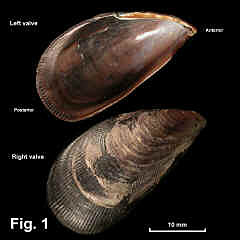|
|
MYTILIDAE |
|
|
Brachidontes rostratus (Dunker, 1857) Description: Shape equivalve, inequilateral, elongate, with umbo at anterior end; variable in width to height ratio. Dorsal margin convex; postero-dorsal end extended, broadly rounded. Hinge with prominent teeth in small specimens, becoming fused together or obsolete in large specimens; usually 2 in left valve and one in right. Ligament long. Interior scars of posterior pedal retractor muscle and adductor muscle combined to give the appearance of a single elongate scar posteriorly; margin crenulated by external sculpture. Exterior with radial riblets. Colour of exterior black; interior dark purple posteriorly, grading to pale purple anteriorly. Periostracum smooth, black, but shell usually eroded. Size: Up to 50 mm in length. Distribution: Sussex Inlet, NSW, southwards to South Australia, including Tasmania. Habitat: This species lives on exposed rocky shores at mid-tide level and below. Individuals form dense aggregations which causes some distortion of shape of crowded individuals. Comparison: Brachidontes erosus (Lamarck, 1819) is a similar species which occurs in southern Australia from Victoria to Western Australia. It has sometimes been confused with B. rostratus, but it does not occur in NSW. Synonymy: Known previously as Austromytilus rostratus (Dunker, 1857). Remarks: The shell of this species varies in shape depending on the degree of crowding when growing. Fig. 1: Twofold Bay, NSW (C.118960) |
||
